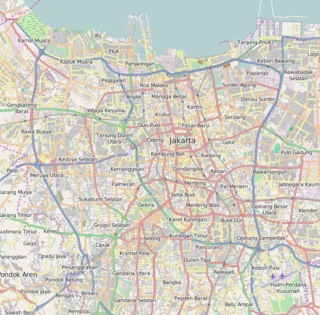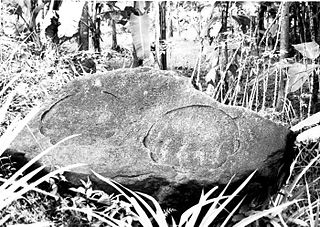

Tugu Kujang berlokasi di Bogor, Jawa Barat, Indonesia. Kujang merupakan senjata tradisional dari masyarakat Sunda. Tugu ini terletak di jalan Pajajaran dekat Kebun Raya Bogor yang telah lama dibangun pada tahun 1982. [1]


Tugu Kujang berlokasi di Bogor, Jawa Barat, Indonesia. Kujang merupakan senjata tradisional dari masyarakat Sunda. Tugu ini terletak di jalan Pajajaran dekat Kebun Raya Bogor yang telah lama dibangun pada tahun 1982. [1]
Depok is a city in West Java province, and located within Jakarta metropolitan area in Indonesia. It has an area of 200.29 km2. As of 2018 census, it had a population of 2,330,333 people, with a density of 11,634 people/km2. Depok was declared as a separate city on 20 April, 1999.

The Jakarta metropolitan area, known locally as Jabodetabek, Jabodetabekjur, or Jabodetabekpunjur, is the most populous metropolitan area in Indonesia. It includes the national capital Jakarta as the core city as well as five satellite cities and four regencies. The original term "Jabotabek" dated from the late 1970s and was revised to "Jabodetabek" in 1999 when "De" was inserted into the name following its formation. The term "Jabodetabekjur" or "Jabodetabekpunjur" was legalised on the Presidential Regulation Number 54 of 2008, although the name Jabodetabek is more commonly used.

The National Monument is a sculpture that commemorates those who died in Malaysia's struggle for freedom, principally against the Japanese occupation during World War II and the Malayan Emergency, which lasted from 1948 until 1960. It is located in the Federal capital, Kuala Lumpur. The Malaysian Houses of Parliament is situated near the monument.

The Bogor Palace is one of six Presidential Palaces of Indonesia, it is located in the city of Bogor, West Java. The palace is noted for its distinctive architectural and historical features, as well as the adjoining botanical gardens. Istana Bogor was opened to the public in 1968 to public tour groups, with the permission of the acting President of Indonesia, Suharto. The gardens of the palace covers an area of 284,000 square metres.

Puncak or Puncak Pass is a mountain pass in West Java, Indonesia. The area is a common weekend destination for residents of Jakarta, including for those who are longing for clean air and natural scenery.

Tugu Stadium is a multi-use stadium in North Jakarta, Indonesia. It is currently used mostly for football matches and is used as the home stadium for Persitara Jakarta Utara. The stadium has a capacity of 5,000 people.
Cikampek is a subdistrict of Karawang Regency, West Java, Indonesia and is divided into 10 administrative villages (kelurahan). The distance from Cikampek to Karawang city is 21 miles.

Tarumanagara or Taruma Kingdom or just Taruma is an early Sundanese Indianised kingdom, located on Western parts of Java, whose 5th-century ruler, Purnawarman, produced the earliest known inscriptions in Java, which estimated dated from around 450 CE.
The Salakanagara Kingdom is the first historically recorded Indianised kingdom in Western Java. The kingdom existed between 130-362 AD.
Claudius Ptolomaeus has written about Java in his book, Geographie Hypogenesis. He mentions name of Argyre Chora in Labadio. According to the Historian, Labadio means Dwipa-Javaka, Dwipa-Javaka or Java Dwipa, is the ancient name of Java Island. There’s one Kingdom, which rule west coast Java in 160 AD, It was Salakanagara Kingdom. Salakanagara means “Silver Nation”. It reinforces the theory that Ptolomaeus might visited Java in 160 AD.
A relatively modern literature in the 17th century Pustaka Rajya Rajya i Bhumi Nusantara describes Salakanagara as being founded by an Indian merchant from Pallava Kingdom.
Kujang may refer to:

The kujang is a blade weapon native to the Sundanese people of West Java, Indonesia. The earliest kujang made is from around the 8th or 9th century. It is forged out of iron, steel and pattern welding steel with a length of approximately 20–25 cm and weighs about 300 grams. According to Sanghyang siksakanda ng karesian canto XVII, the kujang was the weapon of farmers and has its roots in agricultural use. It is thought to have originated from its predecessor, a kudi. The kujang is one of the traditional weapons in the Sundanese school of pencak silat. The kujang, like the keris, is a blade of sentimental and spiritual value to the people of Indonesia, who have a vast belief in supernatural powers.

The Jakarta History Museum, also known as Fatahillah Museum or Batavia Museum, is located in the Old Town of Jakarta, Indonesia. The building was built in 1710 as the Stadhuis of Batavia. Jakarta History Museum opened in 1974 and displays objects from the prehistory period of the city region, the founding of Jayakarta in 1527, and the Dutch colonization period from the 16th century until Indonesia's Independence in 1945.

Parung Panjang Station is a train station that is located in Parung Panjang, Bogor Regency, Indonesia. During the colonial era, this station was important due to the location that is midway between Merak Station and Jakarta Kota Station. Before, the station was the last station that has been upgraded to receive an electrified train. But now, the last station changed to Rangkasbitung Station. The station is located in front of Parung Panjang Market. The road in front of the station is a road from Curug, many commuter from Curug uses this station to go to Jakarta.

The Gedung Agung is one of 6 presidential palaces of Indonesia, it is located in the city Yogyakarta. The palace complex covers an area of approximately 4.4 hectares. It is located in front of Fort Vredeburg.

The History of Bogor includes various rulers leading up to the development of the densely populated Indonesian city of Bogor. The City of Bogor was once the capital of Sunda Kingdom and was known as Pakuan Pajajaranknown. When the Dutch took over, the town was included in an administrative division known as Buitenzorg during the Dutch East Indies era. After independence, the city became part of the Bogor Regency. It has its history reflected in its architecture which includes buildings from the colonial, modern, post-modern, and contemporary periods. Bogor is located south of Jakarta on the island of Java, Indonesia. It is known for its Bogor Palace, Bogor Botanical Garden.

Ciaruteun inscription also written Ciarutön or also known as Ciampea inscription is a 5th-century stone inscription discovered on the riverbed of Ciaruteun River, a tributary of Cisadane River, not far from Bogor, West Java, Indonesia. The inscription is dated from the Tarumanagara kingdom period, one of the earliest Hindu kingdoms in Indonesian history. The inscription states King Purnawarman is the ruler of Tarumanagara.
Kampung Tugu is a historic neighborhood located in the northwestern part of Jakarta, Indonesia. Kampung Tugu grew from the land granted by the government of the Dutch East Indies to the converted Mardijker people in the 17th century. From this land, a Christian settlement grew and developed its own culture. Kampung Tugu is the oldest Christian neighborhood in the western part of Indonesia. Today, the Christian neighborhood of Kampung Tugu is located in the Administrative Village of Tugu in Koja Subdistrict, North Jakarta.

Kebon Kopi I also known as Tapak Gajah inscription, is one of several inscriptions dated from the era of Tarumanagara Kingdom circa 5th century. The inscription bearing the image of elephant footprint, which was copied from the elephant ride of King Purnawarman of Tarumanagara, which is equated with Airavata, the elephant vahana (vehicle) of Indra.

A kudi or kudhi is a bladed tool from Banyumas, Indonesia. Similarly to the parang, it is used to chop or cut wood and bamboo. Like a parang, it only has one sharp edge, however, it has a rather curved shape blade tip like a sickle, with enlarged base. Kudi with slimmer blade may be used as weapon.